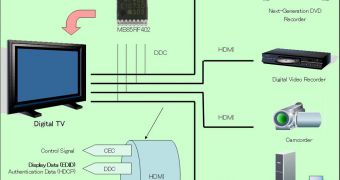It has become quite clear already that HDMI most likely represents the connectivity interface of the future (at least as far as A/V systems are concerned), due to the fact that it supports very high bandwidths and, at this moment, is spreading as the most standardized specification that enables high-quality audio and visual output, in addition to single-cable transmission of control signals for automatic equipment control. And in order to further support the development of HDMI, the people over at Fujitsu developed the world's first embedded-FRAM LSI for digital TVs that enables simultaneous use of four-channel High-Definition Multimedia Interface connector ports.
Via a HDMI connection, products that output video or audio, such as DVD players, first read the display data, such as display resolution and then automatically adjust their output to suit the display. However, with this new LSI, display data from a specific HDMI port can be automatically searched and matching data stored in the FRAM can be automatically converted as output. Thus, the memory function for display data, which previously required four EPROM cells, can now be handled with just one cell. As a result, fewer parts are required - including peripheral parts - thereby enabling a reduction in the overall cost of digital TVs.
Furthermore, previously, the memory for display data required separate memory chips for each HDMI port. However, by combining the memory for 4 ports into one, high-speed data-writing FRAM block on this new LSI product, the time required for the factory programming of data during the production of digital TVs is shortened.
Another important feature provided by the new chip is the fact that it is equipped with a four-channel DDC (Display Data Channel) interface, which communicates the display data sent from the HDMI ports, thereby enabling versatility in the way digital TVs can be used. Practically, the TVs that will be using the new chip will support the connection of a larger number of external devices, while their overall cost will be lower, which makes this invention something to look for in future displays.
We are just a few, but there are many of you, Softpedia users, out there. That's why we thought it would be a good idea to create an email address for you to help us a little in finding gadgets we missed. Interesting links are bound to be posted with recognition going mainly to those who submit. The address is  .
.

 14 DAY TRIAL //
14 DAY TRIAL //